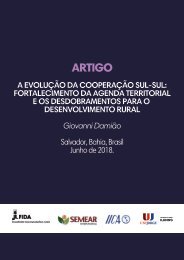The Evolution of South-South Cooperation
Since the Bandung Conference in 1955, the countries of the South have organized themselves in a structured way to achieve better levels of development. This article aims to present the evolution and recent trends of South-South Cooperation, showing how the historical dynamics have led the United Nations and its agencies to adopt a territorial approach, with a strong appeal to mobilize local actors. Allied to this, the increase of the independence of the actors that, with autonomy, manage to dialogue and conduct initiatives of cooperation outside the formal sphere of the central government. This article also aims to present rural development, agriculture and food security as essential factors for the development that since 1978, with BAPA (Buenos Aires Plan of Action), is one of the main thematic lines presented when it comes to the development of the southern agenda. Alongside this, the challenges presented by the prioritization of market dynamics in the face of social development, and how some of the multilateral agencies have worked to promote the facilitation of South-South cooperation and empowerment of minorities, in the achievement of governance as a strategy for endogenous and localized development
Since the Bandung Conference in 1955, the countries of the South have organized themselves in a structured way to achieve better levels of development. This article aims to present the evolution and recent trends of South-South Cooperation, showing how the historical dynamics have led the United Nations and its agencies to adopt a territorial approach, with a strong appeal to mobilize local actors.
Allied to this, the increase of the independence of the actors that, with autonomy, manage to dialogue and conduct initiatives of cooperation outside the formal sphere of the central government. This article also aims to present rural development, agriculture and food security as essential factors for the development that since 1978, with BAPA (Buenos Aires Plan of Action), is one of the main thematic lines presented when it comes to the development of the southern agenda. Alongside this, the challenges presented by the prioritization of market dynamics in the face of social development, and how some of the multilateral agencies have worked to promote the facilitation of South-South cooperation and empowerment of minorities, in the achievement of governance as a strategy for endogenous and localized development
You also want an ePaper? Increase the reach of your titles
YUMPU automatically turns print PDFs into web optimized ePapers that Google loves.
3. CONCLUSION<br />
<strong>The</strong> development <strong>of</strong> the <strong>South</strong>-<strong>South</strong> <strong>Cooperation</strong> agenda stems from the maturation and<br />
consolidation <strong>of</strong> southern countries. Progressively, from 1955, with the Bandung Conference,<br />
cooperation patterns have changed, ranging from a more State-centered sphere, until the 1970s,<br />
and subsequently to a trend toward the incorporation <strong>of</strong> the private initiative from the 1990s. <strong>The</strong>se<br />
movements were represented in the main documents and resolutions <strong>of</strong> the United Nations on the<br />
subject, which still today determine the action guidelines <strong>of</strong> its multilateral agencies, funds,<br />
programs, and conferences.<br />
Within the United Nations framework, the BAPA (1978) was a primordial document to<br />
guide what is understood as <strong>South</strong>-<strong>South</strong> <strong>Cooperation</strong>, and the characteristics derived therefrom.<br />
It presented the idea that countries <strong>of</strong> the political <strong>South</strong> must align to achieve the reversal <strong>of</strong> levels<br />
<strong>of</strong> underdevelopment through skill-sharing, capacity-building, resource allocation, and<br />
technology. Thus, it is possible to create a network among these countries with a view to facilitating<br />
international dialogue and solidarity. Within the BAPA framework, emerge the issues <strong>of</strong> agriculture<br />
and rural development, in conjunction with food safety, as fundamental topic to be introduced as<br />
an important point to be worked in the cooperation process, and, from 1990, the specialized<br />
agencies that deal with this sphere began to participate more actively in the Technical <strong>Cooperation</strong><br />
Among Developing Countries (TCDC).<br />
As a result <strong>of</strong> increased interactions between the State and the private sector, as well as <strong>of</strong><br />
the emergence <strong>of</strong> new actors such as NGOs, the so-called multi-stakeholder approach is<br />
introduced into <strong>South</strong>-<strong>South</strong> cooperation processes, which as a trend raises the actors’ level <strong>of</strong><br />
autonomy so they establish dialogue and together specifically propose development initiatives<br />
contextualized to the different localities. <strong>The</strong>se localities, from the 21st century, come to be valued,<br />
transforming the national strategies, in local development processes, founded on the premise that<br />
local actors, with an emphasis on minorities, should participate actively in the development process<br />
by determining their own demands.<br />
Brazil advanced aligned with the territorialization guidelines, initially with the Territórios<br />
Rurais program (2003) and subsequently Territórios da Cidadania, which aimed primarily at<br />
reaching rural communities, seeking to bring development to the countryside. However, to the<br />
22




